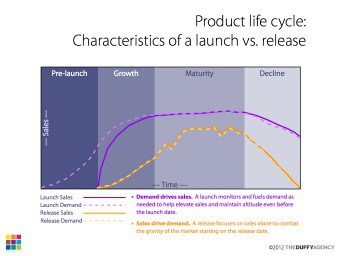Five ways digital is redefining growth strategy
Turbo-charge your growth strategy. Learn the five ways digital changes traditional growth strategy to favor mid-sized businesses....
8 Oct 2024 17975 Views
While growth can be elusive for businesses, the strategy behind it is pretty straight forward. As Igor Ansoff famously illustrated with his growth matrix, there are only two variables: Your product and your target market. To grow you simply play with the four choices these variables offer you.
- Market Penetration: Sell more of your current product to your current market
- Product Development: Sell a new product to your current market
- Market Development: Sell your current product to a new market
- Diversification: Sell a new product to a new market.

These strategies have been taught in business schools since the 1950’s and have been adopted by many of today’s best known brands.
- Market Penetration: Geico invests well over a billion dollars annually in advertising to sell more if its insurance to American car owners. This strategy is often cited as the reason it has become the second largest provider of US Auto insurance.
- Product Development: McDonald’s uses this strategy with a never-ending stream of new “McWhatever” products each month. When you have achieved McDonald’s level of market penetration and development, this strategy becomes more appetizing.
- Market Development: UK sports drink Lucozade used to be sold as a medical remedy for dehydrated children until the company discovered a larger market among adults seeking quick hydration. Targeting the same product to a different market segment tripled the brand’s sales.
- Diversification: The Virgin Group is built around embracing diverse categories with its brand from record stores to airlines to cola. With over 400 different Virgin companies, the group is well insulated from an economic dip in any one category.
Although easy to grasp, these strategies have remained beyond the reach of many companies. That’s because they can take a lot of time and money to implement with no guarantee of success. So implementation has tended to favor large organizations with ample resources, time, and risk tolerance. How many mid-sized companies have the resources to reinvent their product each month like McDonald’s, or dominate the airwaves like Geico? Even if they did, the stakes would be high since failure could have catastrophic business consequences for a mid-sized enterprise.
Historically, this dynamic has helped large companies get larger while posing formidable barriers of entry for small to mid-sized firms. Over the past decade, however, all that has changed. When you add digital to the mix, the playing field between the corporate David and Goliaths is much more even. At my agency, we call this digitally-enabled growth strategy. It differs from traditional growth strategy in five key ways.
Click and find out what does a digital marketing strategist do.
What are the growth strategies in marketing?
1. New Growth Options
First, digital has expanded options for growth twofold. For each traditional strategy we now have a new digital option. This new tier of tactics complements the traditional approaches. The difference between the two is most pronounced when we consider the questions that lie behind each strategy. Approached from a digital perspective, these questions all become less abstract. Simply adding a digital focus makes them more concrete and actionable. To see what I’m talking about, preface each of the growth objectives below with “How can we use digital to…” as opposed to “How can we …” and you’ll see how they come to life.
- Market Penetration:
- Increase rate of consumption
- Take market share from competitors
- Grow the market
- Product Development:
- Add more value to existing products
- Develop entirely new products
- Market Development:
- Develop new segments in current geographical market
- Reach the same segments in new geographical markets – International brand development
- Develop new segments in new geographical markets
- Diversification:
- Develop new products for a new target segments in current geographical market
- Develop new products for existing target segments in new geographical markets
- Develop new products for new target segments in new geographical markets
2. More Feasible for Mid-sized Companies
Second, implementation of digitally-enabled growth strategies is far more feasible for mid-sized companies. That’s because the digital alternative almost always requires less time, less money, and less risk. This puts all four dimensions of growth within the financial reach, time horizons, and risk tolerance of most mid-sized companies.
3. Spill-over Benefits
Third, unlike traditional growth strategies, a successful digitally-enabled growth strategy rarely stimulates growth in just one box without spilling over to the others. So companies that master one digitally-enabled growth strategy tend to have an advantage across all four areas. This makes them nimble and highly disruptive. Consider these pre-2000 brands that have enhanced their growth strategies with digital.
- Digitally-Enabled Market Penetration: Nike uses its online Nike+ community to galvanize customer loyalty and further penetrate the market
- Digitally-Enabled Product Development: Netflix went from sending DVDs through the post to offering streamed movies over the internet.
- Digitally-Enabled Market Development: H&R Block is able to target new geographic regions outside the US, where it lacks a physical presence, with online expat tax preparation for Americans living abroad.
- Digitally-Enabled Diversification: Founded as a design firm catering to Chicago-area retailers in the 1990’s, 37-Signals was able to market its internal project management system. Now branded “BaseCamp” is the second most popular project management software on Earth.
Consider how these companies that excel in one digitally-enhanced growth strategy might benefit from a spill-over effect into the others. For instance the Nike+ online platform has also helped Nike launch new products like its fuel band and develop new markets. With a growing digital distribution network and tons of data on viewing habits, Netflix has been enabled to use its digital platform to venture into film production.
Compare examples like this to Geico spending over a billion dollars each year on market penetration with virtually no spillover in the other three areas. When you employ a digitally-enabled growth strategy in one box, identify and develop the opportunity it creates in the other three.
4. Sequential Success
This is the flip side to the connectivity of the digitally-enabled growth strategies highlighted in the previous section. In the traditional model, success in any one strategy area isn’t necessarily contingent on your success in any of the other areas. For instance, Lucozade could succeed in selling its baby hydration drink to athletes without having first had a market penetration or product development strategy. With the digitally-enabled growth strategy it makes more sense to work though these strategies sequentially since the success of one tends to build off the ones before it.
I’d suggest this order:
- Digitally-Enabled Market Penetration
- Digitally-Enabled Product Development
- Digitally-Enabled Market Development
- Digitally-Enabled Diversification
5. New Demands
In theory, any mid-sized company should find it easier to grow today compared to a decade ago. But there is one hitch. To implement a digitally-enabled growth strategy, your company needs to be digital proficient. If there was ever a reason to increase the digital proficiency of your management and staff, growth is it. This seems to be an area where many senior managers are failing to grasp the urgency. Until now, digital proficiency has been optional for most mid-sized companies. But those days are rapidly drawing to a close. As we move forward, it will become increasingly difficult for companies who lag in digital to compete, no less grow.
The summary of the growth strategies
Digital technology can fuel success in all four of Ansoff’s growth strategies. The number of basement startups selling for billions is testament to that. But the real advantage is how digital has removed the barriers to growth that have prevented many mid-sized businesses from implementing these strategies. The digital revolution has put new growth strategy opportunities within the reach of all mid-size companies. Those who reap the most benefit will be the companies who have developed their digital proficiency. In our next post we’ll explore the digital evolution of mid-sized companies and how you can best prepare for it.
On our blog you will also find an article about challenges of international marketing.
Like this post? You'll find more marketing insights in my new book: International Brand Strategy: A guide to achieving global brand growth, now available from booksellers globally. Order your copy here.







One replay